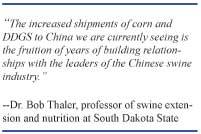China’s swine industry is in the midst of transitioning from backyard and small scale production to large scale production within confined facilities. With this transition comes demand for new feeding, production and health management techniques. Due to its close work over the years with China’s swine industry, the U.S. Grains Council continues to offer technical and management programs that provide the best service to trade.
Dr. Bob Thaler, professor of swine extension and nutrition at South Dakota State University, traveled to China last month to educate swine producers and feed millers on the newly released National Swine Nutrition Guide and FORMULATOR, a least-cost ration balancing program. The workshops were designed to help workers improve their swine nutritional programs and understanding of modern nutritional concepts. Thaler led several workshops, which attracted as many as 300 people from 25 provinces, including leading swine researchers.
The overwhelming interest in Thaler’s sessions reflect the modernization of China’s system and its need for greater quantities of uniform, high-quality feedstuffs to make their operations work.
According to Thaler, that’s where U.S. corn, sorghum, barley and distiller’s dried grains with solubles (DDGS) come into play.
“It doesn’t appear China can produce enough grain for both their human population and livestock. They must import feedstuffs, and the Council has helped position the United States as the market of choice through their long years of service and educational programs,” Thaler said. “The increased shipments of corn and DDGS to China we are currently seeing is the fruition of years of building relationships with the leaders of the Chinese swine industry.”


